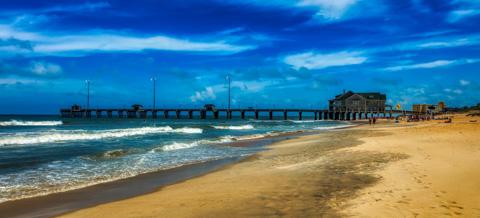How much does it cost to travel to Nags Head?
You should plan to spend around $149 per day on your vacation in Nags Head. This is the average daily price based on the expenses of other visitors.
Past travelers have spent, on average for one day:
- $41 on meals
- $40 on local transportation
- $160 on hotels
A one week trip to Nags Head for two people costs, on average, $2,084. This includes accommodation, food, local transportation, and sightseeing.
All of these average travel prices have been collected from other travelers to help you plan your own travel budget.
Independent Travel
Traveling Independently to Nags Head has many benefits including affordabilty, freedom, flexibility, and the opportunity to control your own experiences.
All of the travel costs below are based on the experiences of other independent travelers.
Is Nags Head expensive to visit?
Prices in Nags Head are reasonable and comparable to your average travel destination. Hotels, food, and sightseeing are generally within normal price ranges.
Within North America, which is known to be an expensive region, Nags Head is a moderately priced destination compared to other places. The overall cost of travel here is fair for the region and comparable to Cumberland Island National Seashore or Winston-Salem.
For more details, and to find out if it's within your travel budget, see Is Nags Head Expensive?
How much money do I need for a trip to Nags Head?
The average Nags Head trip cost is broken down by category here for independent travelers. All of these Nags Head travel prices are calculated from the budgets of real travelers.
|
Category
|
Cost
|
|
Accommodation 1
(Double Occupancy)
|
$160
|
|
Local Transportation 1
|
$40
|
|
Food 2
|
$41
|
|
Entertainment 1
|
$14
|
|
Alcohol 2
|
$6 -
18
|
Accommodation Budget in Nags Head
Calculated from travelers like you
The average price paid for one person for accommodation in Nags Head is $80. For two people sharing a typical double-occupancy hotel room, the average price paid for a hotel room in Nags Head is $160. This cost is from the reported spending of actual travelers.
Looking for a hotel in Nags Head? Prices vary by location, date, season, and the level of luxury. See below for options.
Transportation Budget in Nags Head
Calculated from travelers like you
-
The cost of a taxi ride in Nags Head is significantly more than public transportation. On average, past travelers have spent $40 per person, per day, on local transportation in Nags Head.
-
Transportation1
Taxis, local buses, subway, etc.
$40
How much does it cost to go to Nags Head? Naturally, it depends on the dates. We recommend Kayak because they can find the best deals across all airlines.
The price of renting a car in Nags Head will depends on dates, the type of car, the location, and your age. We recommend Kayak because they can find the best deals across all car rental companies.
Food Budget in Nags Head
Calculated from travelers like you
-
While meal prices in Nags Head can vary, the average cost of food in Nags Head is $41 per day. Based on the spending habits of previous travelers, when dining out an average meal in Nags Head should cost around $16 per person. Breakfast prices are usually a little cheaper than lunch or dinner. The price of food in sit-down restaurants in Nags Head is often higher than fast food prices or street food prices.
-
Food2
Meals for one day
$41
Entertainment Budget in Nags Head
Calculated from travelers like you
-
Entertainment and activities in Nags Head typically cost an average of $14 per person, per day based on the spending of previous travelers. This includes fees paid for admission tickets to museums and attractions, day tours, and other sightseeing expenses.
-
Entertainment1
Entrance tickets, shows, etc.
$14
Alcohol Budget in Nags Head
Calculated from travelers like you
-
The average person spends about $12 on alcoholic beverages in Nags Head per day. The more you spend on alcohol, the more fun you might be having despite your higher budget.
-
Alcohol2
Drinks for one day
$12
Nags Head on a Budget
 Nags Head, NC
Nags Head, NC
Nags Head is a popular tourist destination in the Outer Banks of North Carolina. The town, with a population of almost 3,000, has many nice beaches and is also where you'll find Jockey's Ridge, which has the tallest active sand dune system in the eastern United States. It's also the most visited park within the North Carolina park system.
Nags Head dates back as a resort area to around 1830. The town was incorporated in 1961 and today it attracts visitors from up and down the eastern United States and throughout the country. The Gulf Stream keeps the water warm well into October so swimming may be possible even late in the season. The waves can be rough and some people even enjoy surfing along the coast. Do watch out for rip tides which are common in the area.
Sights
Most people come to Nags Head for the beaches and Jockey's Ridge. The area has wide sand beaches that are great for swimming. The waves can be significant, particularly if there's a storm in the area. Make sure you're comfortable in the water as rip tides are common. A flag system will tell you how rough the water is on any given day. There are three piers in the area that are popular for fishing: Nags Head Peir, Jennette's Pier, and Outer Banks Pier.
Jockey's Ridge State Park is the tallest active sand dune system in the eastern US. It covers 426 acres and has three unique ecosystems: The Roanoke Sound, the sand dune system, and the maritime forest. You can visit the park during the day but there are no campgrounds.
Just to the north, in Kill Devil Hills, is the
Wright Brothers Memorial. Here you can explore the area where the famous brothers made the first ever powered flight in their airplane, as well as tour the museum.
It's also possible to visit Nags Head Woods Ecological Preserve. This area covers 1,092 acres and is to the north of Jockey's Ridge and east of Roanoke Sound.
Neighborhoods
Nags Head covers a total area of about 606 square miles. There is a road and multi use path that runs along the length of town by the beach. The road is referred to as "the beach road" and the parallel path is a good place to walk or ride a bike. You can walk south from Jockey's Ridge for about a mile and a half and you'll reach the Nags Head Cottage Row District. This area has about 60 homes that were built between 1890 and 1930 as summer homes. Most remain unchanged today.
Activities
Most people spend the majority of their time at the beach, swimming, soaking up the sun, or taking walks. There are several public access points to the beach and there is free parking throughout town.
It's also possible to take hang gliding lessons at Jockey's Ridge State Park. The area is also popular for kite flying.
As with most beach towns, miniature golf is popular in the area. There are also several walking paths that you can enjoy if you want to stretch your legs. The path that runs parallel to "the beach road" goes for about twelve miles.
Food and Dining
Nags Head has a decent number of local eateries and restaurants. Predictably, seafood is common, and usually fresh and delicious. Several restaurants have early bird specials if you arrive early (often before 5 pm). Clam chowder and oysters are local favorites. Also make sure you try the homemade ice cream at How Sweet It Is. It's located next to Kitty Hawk Kites in the Jockey's Ridge Crossing Complex. If you want to eat some fantastic food and help the local economy at the same time, check out this
list of the best local Outer Banks restaurants. You won't be disappointed.
Many restaurants do close down during the low season, so if you're in town during the winter months you may not have all of the choices as in the warmer months to find a place to eat.
Transportation
Nags Head is located between Kill Devil Hills and Route 64. The closest airport to Nags Head is in Norfolk, Virginia. Nags Head is also accessible from Raleigh-Durham International Airport and there is a small airport in Manteo, North Carolina, but no scheduled service.
It is essential that you have a car while you're in Nags Head. There are two roads that run north and south through the town: Virginia Dare Trail (also called "Beach Road") and S. Croatan Highway (or Route 158). The Outer Banks also have several ferries that travel between islands. Most ferries require reservations in advance as they do fill up.
Related
Looking for a
party hostel in Las Vegas or
San Diego? Traveling alone to
NYC or
LA? Want a budget hostel in
San Francisco?
We've been gathering travel costs from tens of thousands of actual travelers since 2010, and we use the data to calculate average daily travel costs for destinations around the world. We also systematically analyze the prices of hotels, hostels, and tours from travel providers such as Kayak, HostelWorld, TourRadar, Viator, and others. This combination of expenses from actual travelers, combined with pricing data from major travel companies, gives us a uniqe insight into the overall cost of travel for thousands of cities in countries around the world. You can see more here: How it Works.
 Nags Head, NC
Nags Head, NC

 Budget Your Trip is all about finding out how much everything costs so that you can travel cheaper and longer. Created by avid travelers Laurie and Bryan, our goal is to help you plan your next trip on the right budget. With average daily travel costs that are calculated from the budgets of real travelers, plus an analysis of hotel and tour prices, you can find out how much money you need to plan your next adventure. We also have plenty of travel advice, accommodation reviews, and activity suggestions.
Budget Your Trip is all about finding out how much everything costs so that you can travel cheaper and longer. Created by avid travelers Laurie and Bryan, our goal is to help you plan your next trip on the right budget. With average daily travel costs that are calculated from the budgets of real travelers, plus an analysis of hotel and tour prices, you can find out how much money you need to plan your next adventure. We also have plenty of travel advice, accommodation reviews, and activity suggestions.